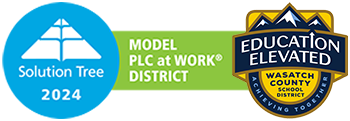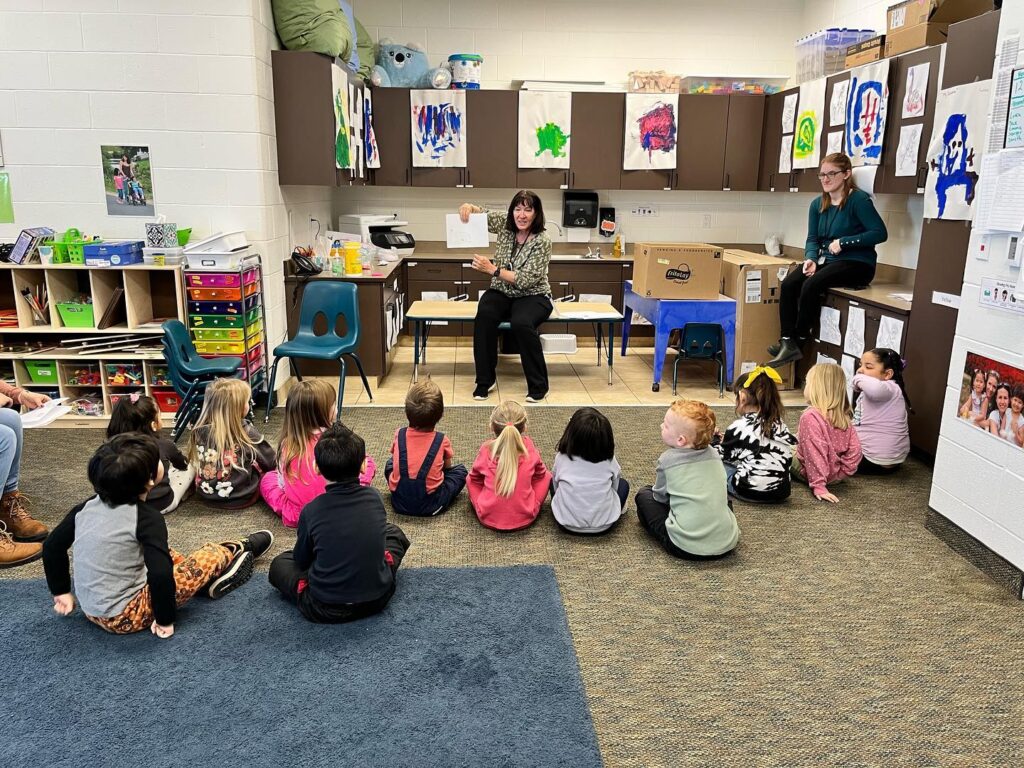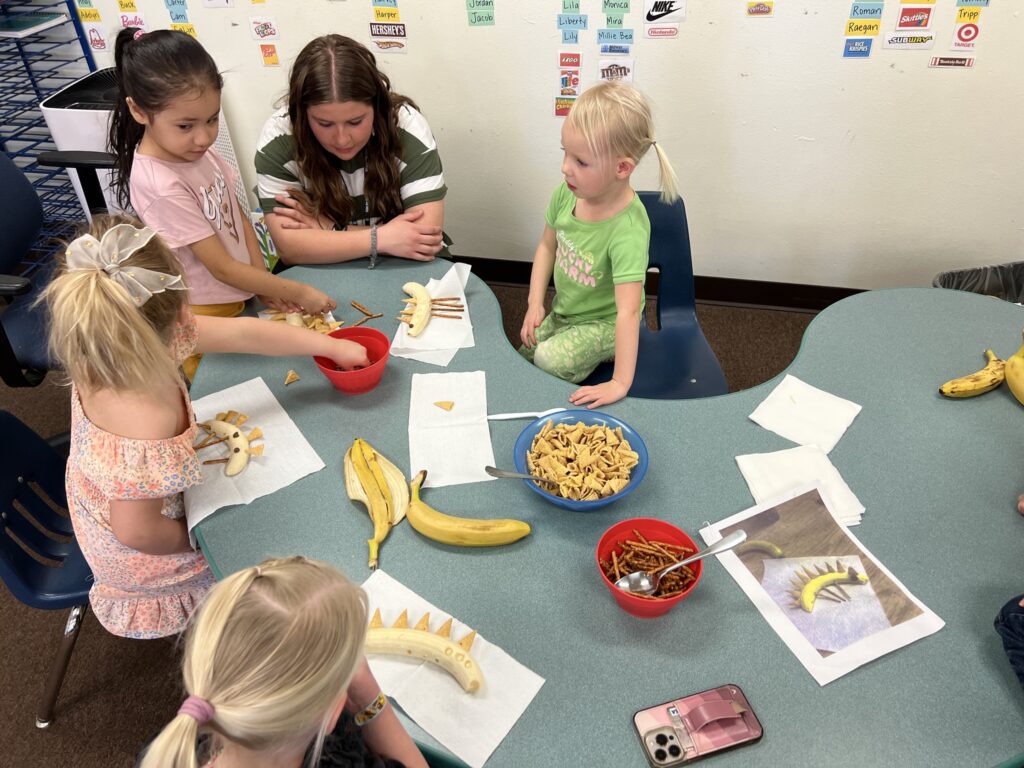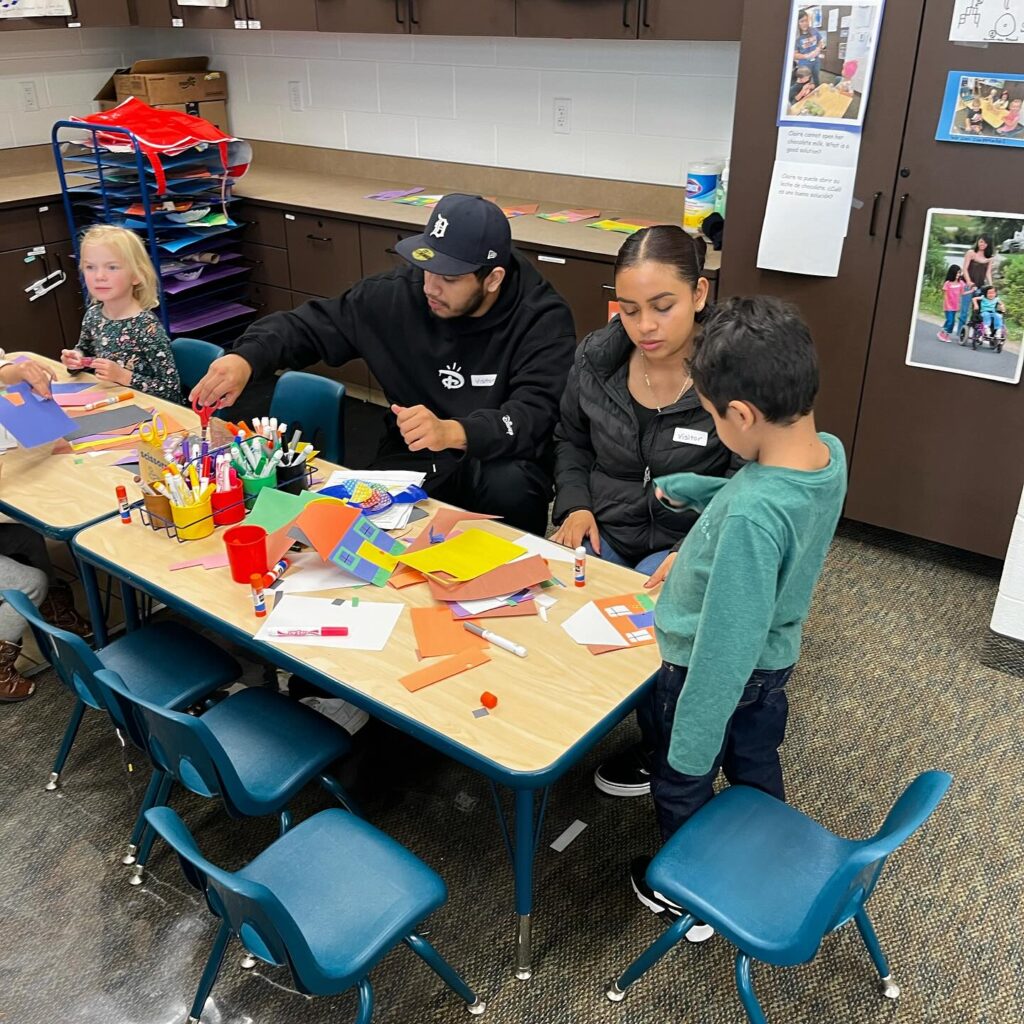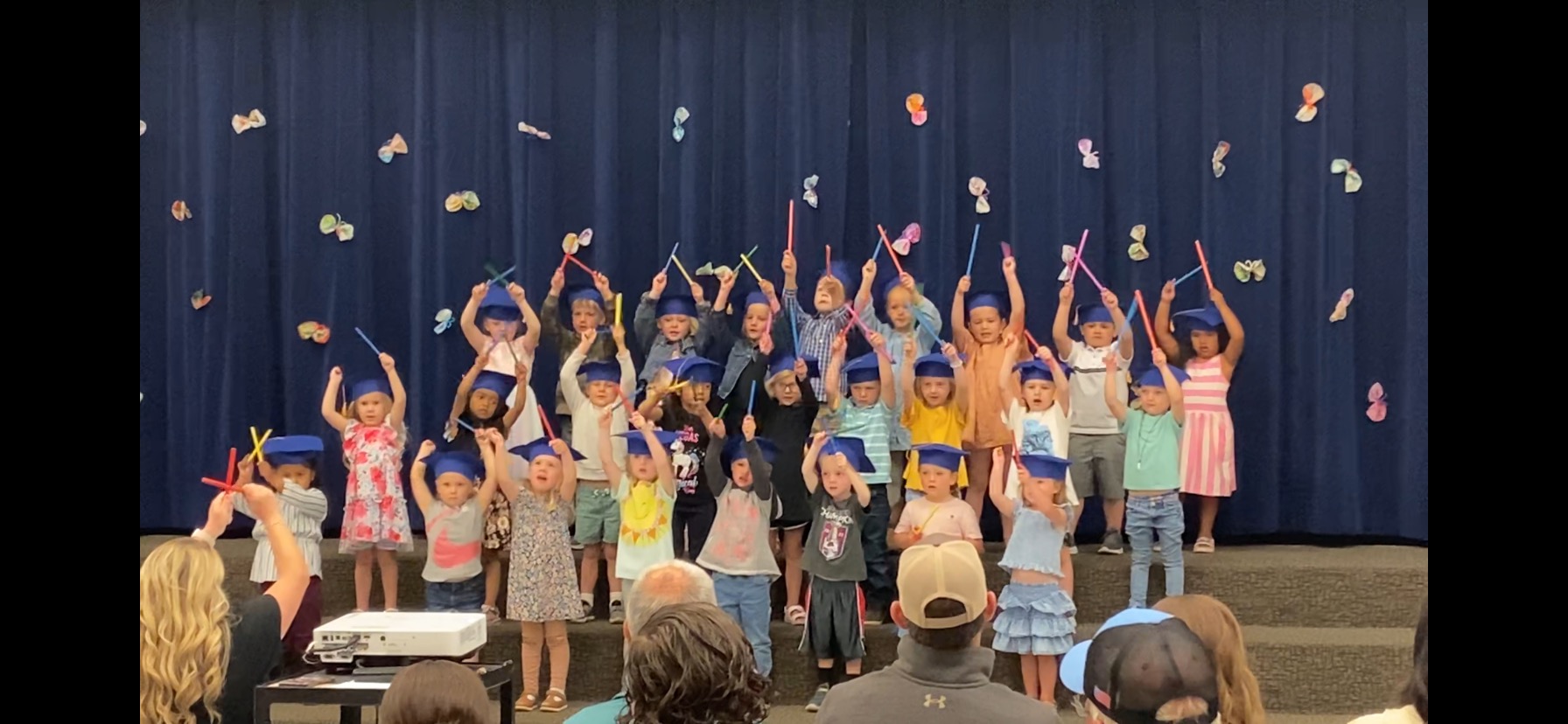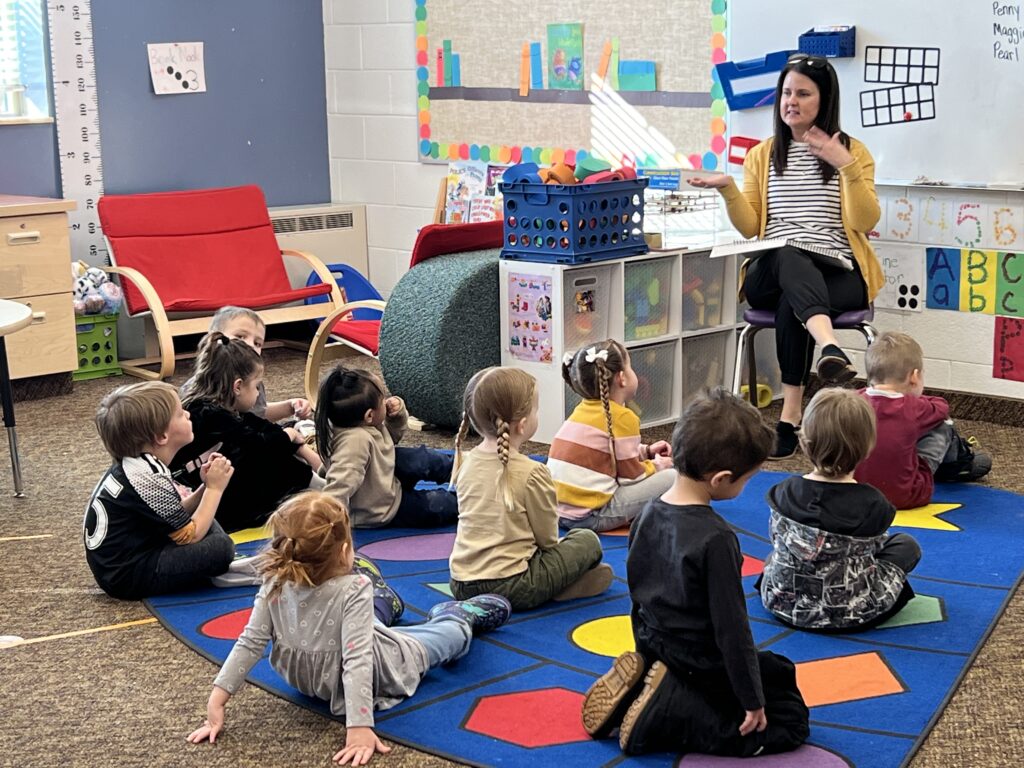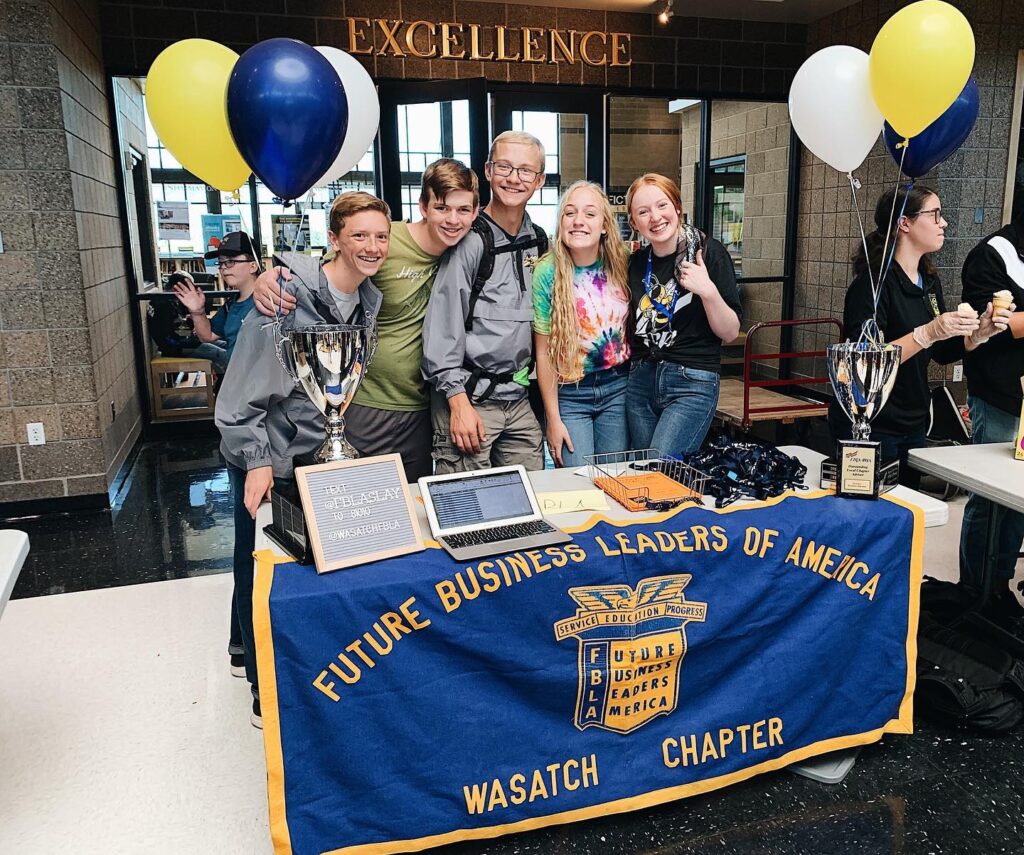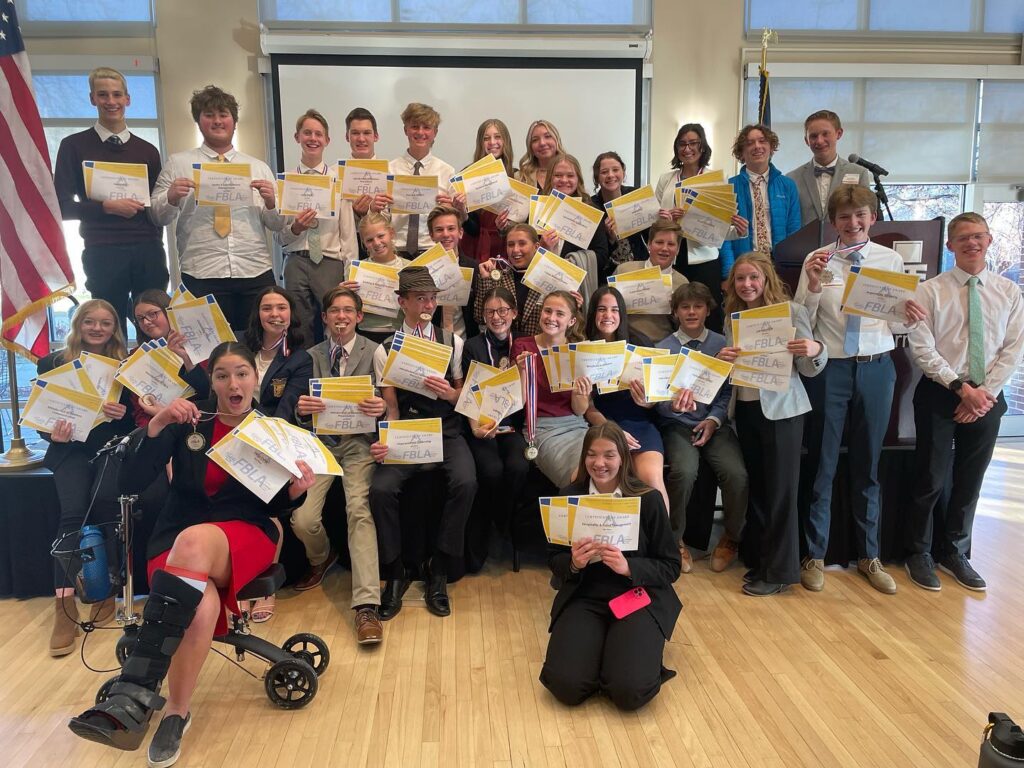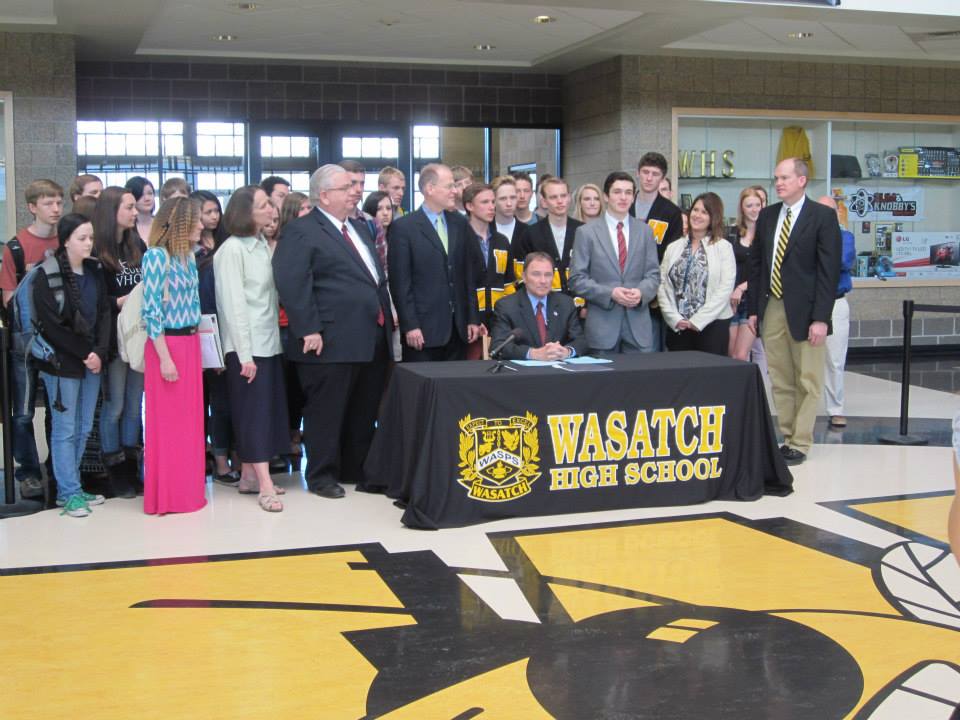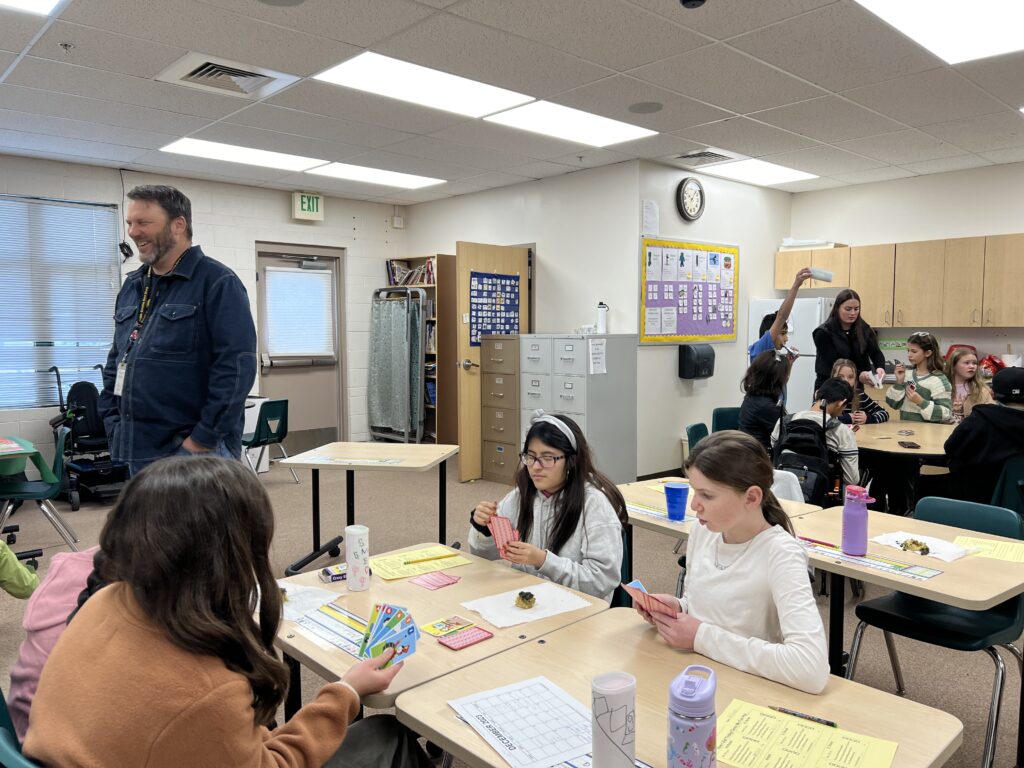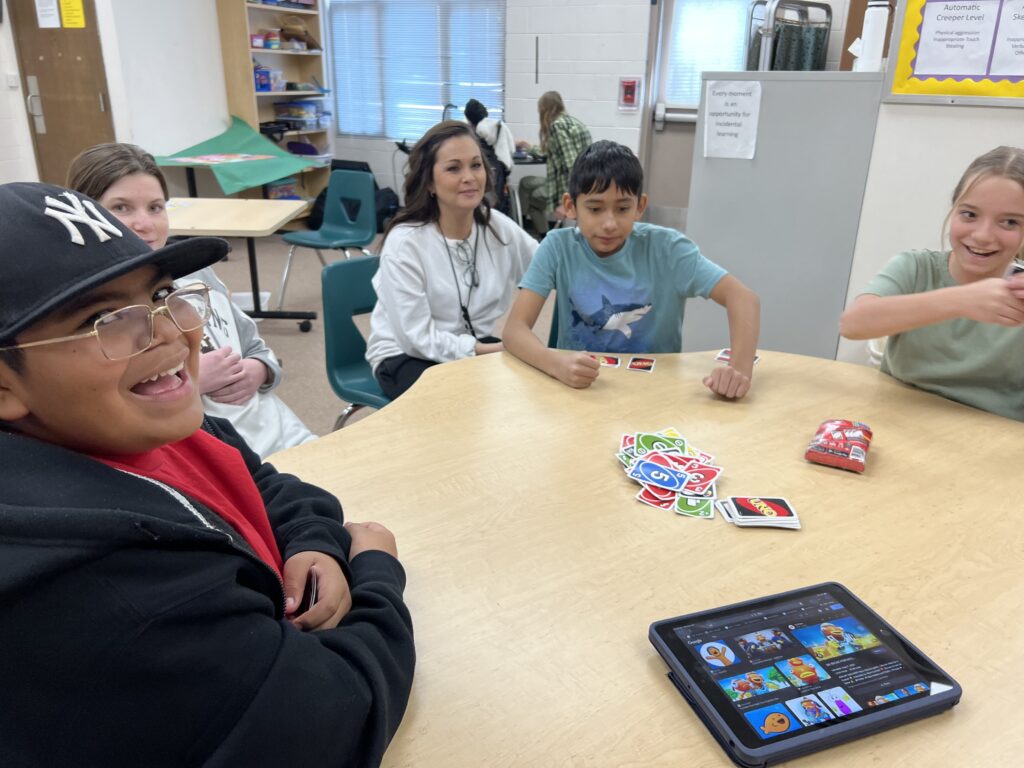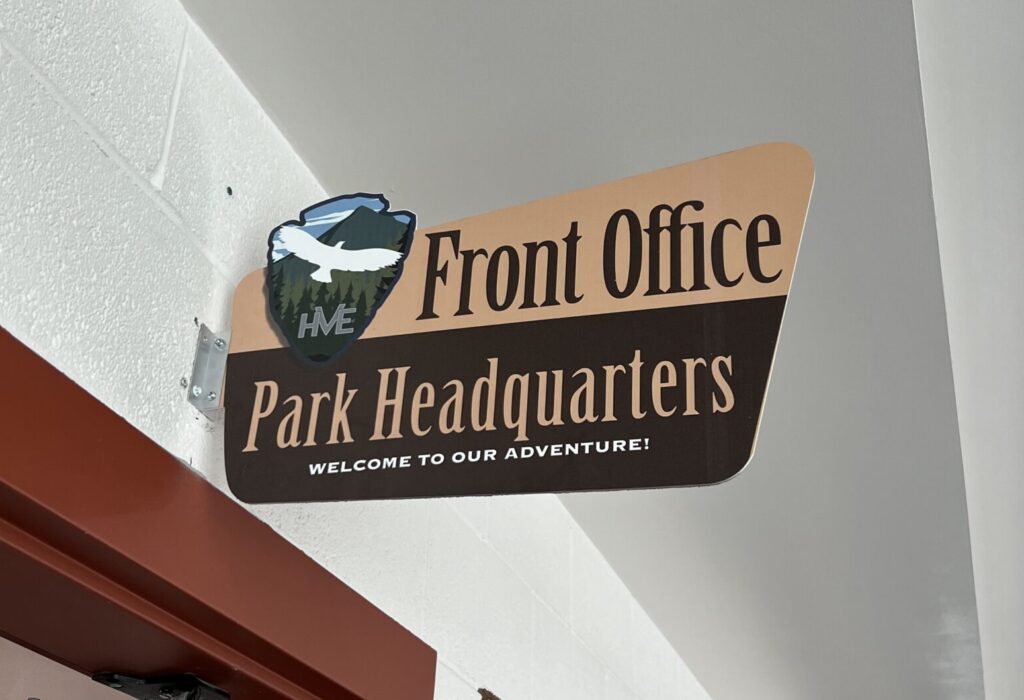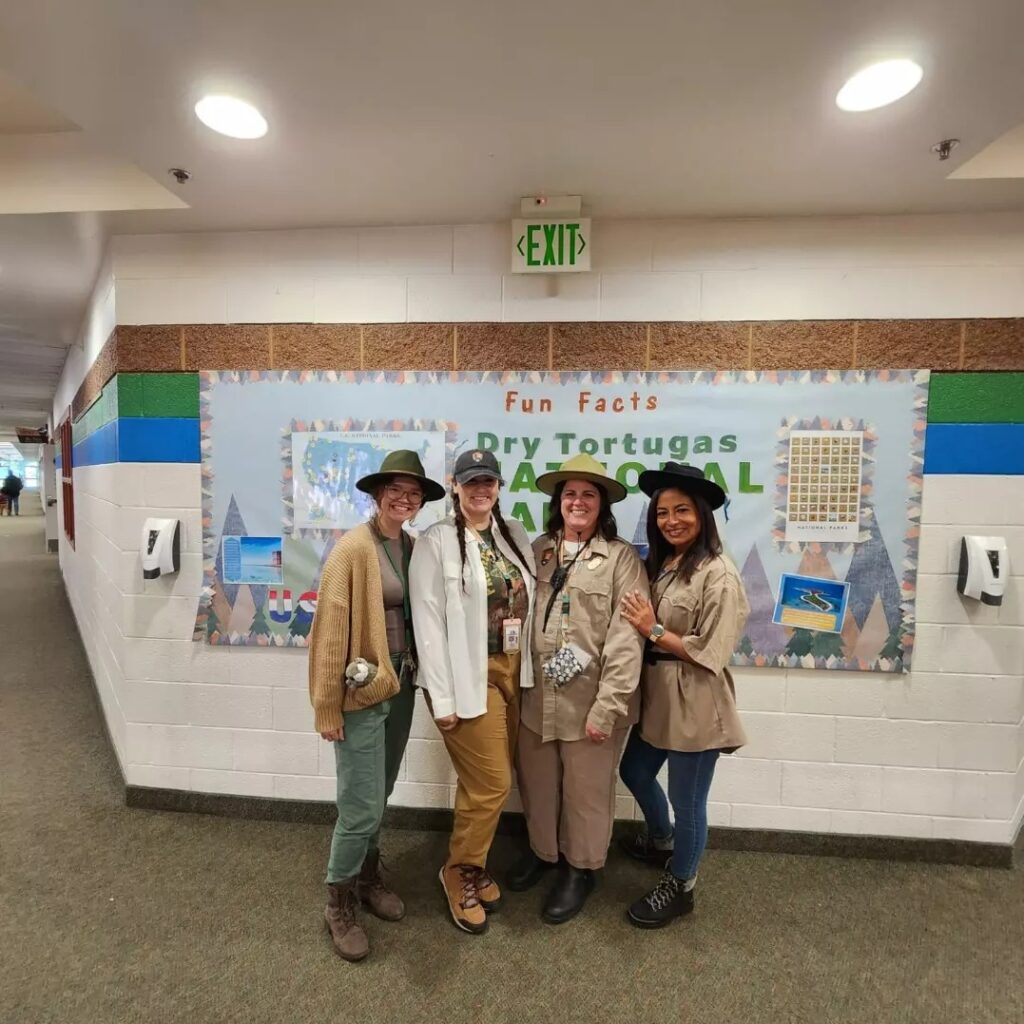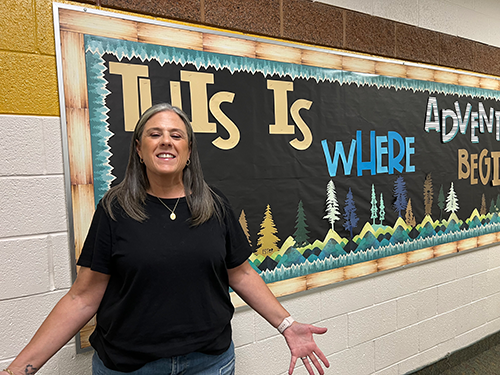Past Distinguished Educators Pave the Way for This Year's Nominations
The annual Distinguished Educator of the Year nominations will be open from March 1 – April 1, 2024, and will recognize 13 amazing teachers within Wasatch County School District who help students achieve every day!
To kick off this year’s program, we interviewed some of the past Distinguished Educator of the Year recipients for this edition of The Wasatch Way.
Click on the video to hear what receiving the distinction meant to each of them, then visit bit.ly/2024DistinguishedEducator to nominate a teacher who inspires you! Nominees must meet the criteria included at the above link, and please share why your nominee should join the prestigious ranks of Wasatch educators who have received the award before them.
Preschool Prepares Young Learners for Lifelong Academic Success
When it comes to engaged learning, Wasatch County School District starts with its youngest students, providing high-quality preschool for three- and four-year-olds at each elementary school to give them an academic head start.
District Preschool uses a dual-classroom approach, with one room for teacher-directed instruction and another for child-led discovery. Math, literacy, and fine motor skills are covered, in addition to offering access to services from Speech, Occupational, and Physical Therapists. The program also prepares children for kindergarten by teaching them essential skills through both structured instruction and play, helping them to become academically and socially ready for kindergarten.
It’s the early access to Speech services in preschool that’s been a game-changer for Midway Elementary parents Courtney and Jeff Miller, whose four-year-old is in her third year of District preschool thanks to the Early Start program at Heber Valley Elementary.
“At 18 months, we noticed that our daughter had a speech delay,” Mrs. Miller tells us. “At three years old, she started in Early Start (at Heber Valley). She had time with her speech-language pathologist in that classroom and made a lot of growth. This year she’s at Midway Elementary Preschool, where she also sees a speech-language pathologist, and has peers model things for her, which has been super helpful. Her growth in language has been exponential.”
Tara Boswell, District Preschool Coordinator, points out that the program prepares students both academically and socially for kindergarten, while also helping parents to understand school procedures and communications.
“There are so many benefits for both the students and the parents within our program,” Mrs. Boswell explains. “And of course, it’s fun and we have great feedback from our kindergarten teachers because the kiddos are ready. They understand how to navigate the schools. They know that it’s a safe place, and when children feel safe, they’re ready to learn.”
According to the U.S. Department of Education, “High-quality preschool provides the foundation for children’s success in school and helps to mitigate educational gaps that exist between children from high- and low-income families before they enter kindergarten.” Economists James J. Heckman and Dimitriy V. Masterov contend that high-quality preschool is a wise economic investment: For every $1 invested in high-quality preschool, taxpayers save an average of $7 in future costs due to reductions in remedial education costs, increased labor productivity, and a reduction in crime.
Julie Patterson, WCSD Special Education Preschool Teacher, says preschool gives students an opportunity to learn how to “school,” providing the foundation for social and academic skills they’ll build upon as the progress through their education.
“Preschool teaches how to be a student, how to sit appropriately, how to follow directions in a group,” explained Mrs. Patterson. “They participate in whole group activities and learn to have friends, and how we can all be friends together.”
She further explained that many of the programs used in preschool are also used in kindergarten, which helps them transition more easily to that next level.
Preschool Teacher Tana Davis says it also gives an academic head start to students whose primary language is Spanish. “For some students, it’s their first exposure to the English language, and we’re helping them every step of the way,” Mrs. Davis said. “They may not speak a lot to us in English the first year, but by the second year, they are talking a lot. The progress we see in those who are multi-lingual, they are soaring and ready to go into kindergarten.”
The District’s preschool curriculum is comprised of six-week units with topics that include, “Our Environment,” “How Structures are Built,” “Exploring Museums,” and “Growing Our Garden.”
Each preschool academic unit culminates in a Parent Engagement activity, providing an opportunity for parents to see firsthand how and what their children have been learning. During these activities, students act as teachers, demonstrating to their families the knowledge and skills learned during the previous six weeks.
“We invite parents in, and it’s a great opportunity to have more parent participation within our schools,” Mrs. Boswell explains, adding, “It gets parents familiar with the schools and the school culture, so as their kiddos go up to the grades, they are feeling welcome and part of the school community.
She notes that including parents in their child’s celebration of learning helps to increase parents’ familiarity with the academic, language, and social concepts their students are learning in our preschool programs. “It bridges home and school communication and builds relationships with parents and teachers. Students are also empowered to ‘share what they know,’ increasing their self-awareness and advocacy skills,” Mrs. Boswell says.
Preschool Teacher Sunni Provost agrees. “It’s just such a feel-good moment to see families engage with one another,” Mrs. Provost says. “I saw little play dates organized and families bonding over their children being in the same classrooms. And if the students’ parents are unable to attend, we grab some of our fifth grade kids and they go through the activities.”
Molly Brown, WCSD Teacher and parent of a preschooler at J.R. Smith Elementary says she appreciates the opportunity to observe her child’s learning process in school, and finds it rewarding to see her children engaged in games and learning activities.
“As a parent, it’s amazing to be able to go in and see what my student is learning, and to actually see how they’re learning,” Mrs. Brown nots. “They’re engaged in games and learning activities, and I get to watch them do it, and those are ideas we can practice at home.”
The 2024-25 preschool lottery is open now through March 1. To register, visit wasatch.edu/preschool/.
When it comes to engaged learning, Wasatch County School District starts with its youngest students, providing high-quality preschool for three- and four-year-olds at each elementary school to give them an academic head start.
District Preschool uses a dual-classroom approach, with one room for teacher-directed instruction and another for child-led discovery. Math, literacy, and fine motor skills are covered, in addition to offering access to services from Speech, Occupational, and Physical Therapists. The program also prepares children for kindergarten by teaching them essential skills through both structured instruction and play, helping them to become academically and socially ready for kindergarten.
It’s the early access to Speech services in preschool that’s been a game-changer for Midway Elementary parents Courtney and Jeff Miller, whose four-year-old is in her third year of District preschool thanks to the Early Start program at Heber Valley Elementary.
“At 18 months, we noticed that our daughter had a speech delay,” Mrs. Miller tells us. “At three years old, she started in Early Start (at Heber Valley). She had time with her speech-language pathologist in that classroom and made a lot of growth. This year she’s at Midway Elementary Preschool, where she also sees a speech-language pathologist, and has peers model things for her, which has been super helpful. Her growth in language has been exponential.”
Tara Boswell, District Preschool Coordinator, points out that the program prepares students both academically and socially for kindergarten, while also helping parents to understand school procedures and communications.
“There are so many benefits for both the students and the parents within our program,” Mrs. Boswell explains. “And of course, it’s fun and we have great feedback from our kindergarten teachers because the kiddos are ready. They understand how to navigate the schools. They know that it’s a safe place, and when children feel safe, they’re ready to learn.”
According to the U.S. Department of Education, “High-quality preschool provides the foundation for children’s success in school and helps to mitigate educational gaps that exist between children from high- and low-income families before they enter kindergarten.” Economists James J. Heckman and Dimitriy V. Masterov contend that high-quality preschool is a wise economic investment: For every $1 invested in high-quality preschool, taxpayers save an average of $7 in future costs due to reductions in remedial education costs, increased labor productivity, and a reduction in crime.
Julie Patterson, WCSD Special Education Preschool Teacher, says preschool gives students an opportunity to learn how to “school,” providing the foundation for social and academic skills they’ll build upon as the progress through their education.
“Preschool teaches how to be a student, how to sit appropriately, how to follow directions in a group,” explained Mrs. Patterson. “They participate in whole group activities and learn to have friends, and how we can all be friends together.”
She further explained that many of the programs used in preschool are also used in kindergarten, which helps them transition more easily to that next level.
Preschool Teacher Tana Davis says it also gives an academic head start to students whose primary language is Spanish. “For some students, it’s their first exposure to the English language, and we’re helping them every step of the way,” Mrs. Davis said. “They may not speak a lot to us in English the first year, but by the second year, they are talking a lot. The progress we see in those who are multi-lingual, they are soaring and ready to go into kindergarten.”
The District’s preschool curriculum is comprised of six-week units with topics that include, “Our Environment,” “How Structures are Built,” “Exploring Museums,” and “Growing Our Garden.”
Each preschool academic unit culminates in a Parent Engagement activity, providing an opportunity for parents to see firsthand how and what their children have been learning. During these activities, students act as teachers, demonstrating to their families the knowledge and skills learned during the previous six weeks.
“We invite parents in, and it’s a great opportunity to have more parent participation within our schools,” Mrs. Boswell explains, adding, “It gets parents familiar with the schools and the school culture, so as their kiddos go up to the grades, they are feeling welcome and part of the school community.
She notes that including parents in their child’s celebration of learning helps to increase parents’ familiarity with the academic, language, and social concepts their students are learning in our preschool programs. “It bridges home and school communication and builds relationships with parents and teachers. Students are also empowered to ‘share what they know,’ increasing their self-awareness and advocacy skills,” Mrs. Boswell says.
Preschool Teacher Sunni Provost agrees. “It’s just such a feel-good moment to see families engage with one another,” Mrs. Provost says. “I saw little play dates organized and families bonding over their children being in the same classrooms. And if the students’ parents are unable to attend, we grab some of our fifth grade kids and they go through the activities.”
Molly Brown, WCSD Teacher and parent of a preschooler at J.R. Smith Elementary says she appreciates the opportunity to observe her child’s learning process in school, and finds it rewarding to see her children engaged in games and learning activities.
“As a parent, it’s amazing to be able to go in and see what my student is learning, and to actually see how they’re learning,” Mrs. Brown nots. “They’re engaged in games and learning activities, and I get to watch them do it, and those are ideas we can practice at home.”
The 2024-25 preschool lottery is open now through March 1. To register, visit wasatch.edu/preschool/.
Wasatch Future Business Leaders of America: A 50-Year Legacy of Leadership and Service
For 50 years, the Future Business Leaders of America (FBLA) chapter at Wasatch High School (WHS) has a place where students can develop leadership skills, engage in community service and find a sense of belonging among their fellow members.
An international organization comprised of more than 230,000 members worldwide at the college, middle and high school levels, FBLA’s mission is centered around three ideals: Service, Education, and Progress.
It’s the service ideal that WHS students and staff actively embrace this time of year through the chapter’s long-standing “Sub for Santa” program, which has raised tens of thousands of dollars over the past few decades to give Christmas to 25 deserving local families every December.
According to Kristen DiStefano, WHS Business Teacher & FBLA Advisor, the Sub for Santa program, which operates in conjunction with Wasatch County Search & Rescue to help source the families to support, provides an excellent service leadership opportunity for students.
“It is so great for the students to be involved on so many levels,” Mrs. DiStefano said, noting the chapter members coordinate everything themselves, from raising money, to shopping for the gifts and wrapping the presents.
This year’s FBLA Sub for Santa has been led by 12th Grader Sydney H., who says she sees teachers encouraging students to consider the circumstances of less fortunate families by supporting the program, and it’s an act of kindness that bring happiness to both the students and the teachers.
“Over Christmas, people just want to give and want to share joy, and there is a joy that you receive from participating in a program like Sub for Santa,” Sydney said. “When they see these kids really initiating themselves to do good, it brings satisfaction for everyone because they’re helping other people.”
She said the program becomes particularly impactful to her and her fellow students when they see the effect it has on families whose students attend Wasatch.
“We do this to serve these families because we see the need, and we’ve noticed that it’s immediate here in our high school and within friends that are close to us,” Sydney explained. “It really hits home when you know that there’s people so close to you with those circumstances.”
When asked about the type of students who are a good fit for FBLA, club advisor Mrs. DiStefano says it can be a good fit for anyone in grades nine through 12 interested in making connections, engaging in service and developing leadership skills.
“So much of the world connects back to business that I feel like a lot of students can find something that is interesting and beneficial to them when they join FBLA,” Mrs. DiStefano said, adding, “FBLA offers its members the opportunity to not only compete in different business events and subjects but also gives students the chance to lead the club here at the high school while they also build leadership skills by competing at the state level and national level,”
Wasatch Class of 2014 grad Luke Searle says his experience with FBLA helped him navigate being new to the Heber Valley as he entered high school, and continues to influence him as he moves forward in his career.
A current Wasatch County Council Member and business teacher at WHS, Mr. Searle recognizes that the path he’s now following as an elected official and educator embodies the FBLA goals of Service, Education and Progress, but says it all began by wanting to make worthwhile connections and friends.
Explaining that as a student, he chose to join FBLA at WHS both to help make new friends and because of its track record of success in competition, Mr. Searle eventually went on to serve as a state chapter representative and then president.
“Once I had gone to a competition, I did find those friends and I was successful in competing and really caught that fire that I could go and do anything that I wanted,” he said. “It such a good opportunity to have these experiences and know that I could do this in my life.”
While he was a student at WHS, Mr. Searle worked closely with State Representative Kraig Powell to create and present H.B. 282, a bill that allows 16 and 17 year olds to work as poll workers and also prohibits family members of candidates on the ballot to work as poll workers. He says that experience, which culminated in then Governor Gary Herbert traveling to Wasatch to sign the bill into law, was rooted in his experiences in FBLA.
“There are people in your life that come, that mentor you, that show you things that you’ve never thought about before,” Mr. Searle explained. “When I had the opportunity to help younger people be even more involved, I jumped at that opportunity, and based on my experience with FBLA, I knew I could do it.”
Current Wasatch FBLA President Abigail W. agrees, noting that she joined FBLA because she believed it would provide her with the confidence, friendship, and tools she could use in her future career.
“FBLA gives you so many skills,” she said. “You’re always going to need to know how to have confidence. You’re always going to need to know how to work with people and how to solve critical problems. And FBLA puts you in those situations before you actually experience them so that you can learn how to work them out and how to gain those skills before you go into the real world.”
While building leadership ability has been an important takeaway for Abigail, it’s the interpersonal skills she most values from her involvement with the club.
“It’s taught me how to work with other people, and I know that I’m going to use that leadership experience the rest of my life,” she said.
It’s this opportunity to connect with other students that FBLA Vice-President Antonia D. highlights when talking about why she joined the club, explaining that she’s found it to be a perfect blend of gaining practical experience for the future and enjoying the present with bonding activities like overnight competitions.
She also pointed out that the experience has been invaluable as she gets ready to continue her post-secondary studies. “As I’m preparing to go to college, FBLA has been a huge advantage because it’s taught me how to work in a team,” Antonia said.
For more information and updates about Wasatch FBLA, visit https://www.facebook.com/wasatchbusiness/about
RMMS Students Build Special Relationships During “Fun with Friends”
At Rocky Mountain Middle School, a special bond is forming between students of all abilities, thanks to a new activity called “Fun with Friends.”
Fun with Friends happens during “Stretch Time” — a half-hour period carved out of every day that allows students additional time for learning, while also providing a variety of enrichment opportunities for students who grasp concepts quickly. Fun with Friends is one such enrichment program that pairs Peer Tutors with students with significant disabilities in the “Learning Lab” fostering interaction and understanding during Stretch Time as they play traditional games together.
According to Principal Brian Thorne, one of the most positive impacts of the program has been students actively seeking to participate, along with the increased integration of students with disabilities throughout the day.
“Our (general education) kids have been reaching out, wanting to participate in Fun with Friends,” Principal Thorne said. “And then at lunch, I started noticing our students with disabilities who used to all sit together at the same table starting to sit at other tables with their new friends. Then, some of our kids started playing games at lunch, and, I’m like, ‘this is amazing’.”
RMMS 8th Grader Kate B. says Fun with Friends could be a great opportunity for all students. “I think it’s a really cool experience and I think that would be really fun for a lot of people,” she said.
Glenda Gray, a 20-year veteran Special Education teacher at RMMS says the program has had a significant impact on the students in the Learning Lab, helping them make friends, learn respect, and develop skills necessary for independence.
“They have friends who greet them in the hall, and have somebody to sit with in the lunchroom,” Mrs. Gray said. “They get to practice the skills we’ve been teaching them about personal space and showing respect, along with other things they need to know to be independent in life.”
According to RMMS Special Education teacher Abbi Wright, the impact of participating in Fun with Friends is profound for the Peer Tutors.
“I think it makes them better people,” Mrs. Wright said. “It makes them more understanding of people that are different than them. I think it helps them grow a love for people that are different and helps them understand there are things they can learn from them, even though they’re different.”
She also said she encourages students to consider Peer Tutoring, which she participated in as a student at Wasatch High School before graduating in 2018, noting that it “changed my life.”
For RMMS 6th Grader Ellie H., participating in Fun with Friends allows her to connect with other kids of all abilities, and reminds us, “Just because people are different, it doesn’t mean that they should be treated any different than us.”
Walking through the halls of Heber Valley Elementary, visitors will notice something new this year, from hallway bulletin boards to each classroom’s teacher signs.
That’s because Heber Valley has embraced a “National Parks” theme throughout the school, which has been incorporated not only in the adoption of iconic National Parks entryway signs as classroom identifiers, but also through student activities, curriculum, and its PBIS (Positive Behavioral Interventions and Supports) systems.
According to HVE Principal Katie Cummings, selecting the National Parks for this year’s theme was a natural choice for the school, beginning with the school’s mascot, the eagle.
“We wanted to have a theme that could connect us with the eagle and build pride in our mascot,” Mrs. Cummings said. “Thinking of nature being where eagles live, our thoughts went to the National Parks.
She further noted that, like National Parks, Heber Valley is a special place that needs to be protected. “There are many lessons we can learn from nature,” Mrs. Cummings said. “Plus, those who are in the national parks take care of them, and we want our students to take pride in our school. This is a theme that will continue to develop over the next few years.”
Creating a school-wide theme helps build spirit and morale among both students and staff and can positively affect student behaviors and test scores, which is why it’s been incorporated into Heber Valley’s PBIS system. PBIS is an evidence-based, tiered framework for supporting students’ behavioral, academic, and mental health that can improve academic success and school climate.
At Heber Valley, the front office has become Park Headquarters, and each grade and team has selected a National Park to embrace throughout the year. The teams have decorated the offices and hallways in their area to match the theme, which include:
PreK: Sequoia National Park
Kindergarten: Saguaro National Park
1st Grade: Zion National Park
2nd Grade: Yosemite National Park
3rd Grade: Yellowstone National Park
4th Grade: Bryce Canyon National Park
5th Grade: Arches National Park
Specials: Grand Canyon National Park
Special Education: Capitol Reef National Park
Intervention: Hawaii Volcanoes National Park
For Heber Valley 2rd grader, Bridger M., it’s been especially fun to come to school this year because his grade level is learning about Yosemite National Park – a place where his uncle served as a park ranger.
Mrs. Cummings said the connection inspired Bridger to enthusiastically embrace the theme right from the beginning of the year and is an example of how the theme supports school climate without students realizing its intention and goes beyond kids being immersed in a topic they happen to find interesting.
Allowing each team to choose their own park supports the Professional Learning Community (PLC) model that schools in Wasatch County School District follow. The PLC model helps teachers work collaboratively to achieve better results for students by sharing best practices and brainstorming innovative ways to improve learning and drive student achievement.
“It’s been great to see students and teachers excited about the theme,” she said, adding, “The grade levels each use their park in different ways. When our staff teaches about it, they use different landmarks as stops along the way to reaching grade-level goals.”
According to Third Grade teacher, Monique Straughan, the National Parks theme has positively impacted each grade-level PLC and gets the students excited about learning.
“I think the National Park theme has really joined our school together because we got to choose which park we wanted as a team, and it just brings us all together as one focus,” Mrs. Straughan said. “The kids are really into it because they like to follow the rules of the national parks, which we have tied into our school, so it unifies everything and brings us all under one umbrella.”
Previous Wasatch Way Features (click on the headline to read)...
Preschool Prepares Young Learners for Lifelong Academic Success
When it comes to engaged learning, Wasatch County School District starts with its youngest students, providing high-quality preschool for three- and four-year-olds at each elementary school to give them an academic head start.
District Preschool uses a dual-classroom approach, with one room for teacher-directed instruction and another for child-led discovery. Math, literacy, and fine motor skills are covered, in addition to offering access to services from Speech, Occupational, and Physical Therapists. The program also prepares children for kindergarten by teaching them essential skills through both structured instruction and play, helping them to become academically and socially ready for kindergarten.
It’s the early access to Speech services in preschool that’s been a game-changer for Midway Elementary parents Courtney and Jeff Miller, whose four-year-old is in her third year of District preschool thanks to the Early Start program at Heber Valley Elementary.
“At 18 months, we noticed that our daughter had a speech delay,” Mrs. Miller tells us. “At three years old, she started in Early Start (at Heber Valley). She had time with her speech-language pathologist in that classroom and made a lot of growth. This year she’s at Midway Elementary Preschool, where she also sees a speech-language pathologist, and has peers model things for her, which has been super helpful. Her growth in language has been exponential.”
Tara Boswell, District Preschool Coordinator, points out that the program prepares students both academically and socially for kindergarten, while also helping parents to understand school procedures and communications.
“There are so many benefits for both the students and the parents within our program,” Mrs. Boswell explains. “And of course, it’s fun and we have great feedback from our kindergarten teachers because the kiddos are ready. They understand how to navigate the schools. They know that it’s a safe place, and when children feel safe, they’re ready to learn.”
According to the U.S. Department of Education, “High-quality preschool provides the foundation for children’s success in school and helps to mitigate educational gaps that exist between children from high- and low-income families before they enter kindergarten.” Economists James J. Heckman and Dimitriy V. Masterov contend that high-quality preschool is a wise economic investment: For every $1 invested in high-quality preschool, taxpayers save an average of $7 in future costs due to reductions in remedial education costs, increased labor productivity, and a reduction in crime.
Julie Patterson, WCSD Special Education Preschool Teacher, says preschool gives students an opportunity to learn how to “school,” providing the foundation for social and academic skills they’ll build upon as the progress through their education.
“Preschool teaches how to be a student, how to sit appropriately, how to follow directions in a group,” explained Mrs. Patterson. “They participate in whole group activities and learn to have friends, and how we can all be friends together.”
She further explained that many of the programs used in preschool are also used in kindergarten, which helps them transition more easily to that next level.
Preschool Teacher Tana Davis says it also gives an academic head start to students whose primary language is Spanish. “For some students, it’s their first exposure to the English language, and we’re helping them every step of the way,” Mrs. Davis said. “They may not speak a lot to us in English the first year, but by the second year, they are talking a lot. The progress we see in those who are multi-lingual, they are soaring and ready to go into kindergarten.”
The District’s preschool curriculum is comprised of six-week units with topics that include, “Our Environment,” “How Structures are Built,” “Exploring Museums,” and “Growing Our Garden.”
Each preschool academic unit culminates in a Parent Engagement activity, providing an opportunity for parents to see firsthand how and what their children have been learning. During these activities, students act as teachers, demonstrating to their families the knowledge and skills learned during the previous six weeks.
“We invite parents in, and it’s a great opportunity to have more parent participation within our schools,” Mrs. Boswell explains, adding, “It gets parents familiar with the schools and the school culture, so as their kiddos go up to the grades, they are feeling welcome and part of the school community.
She notes that including parents in their child’s celebration of learning helps to increase parents’ familiarity with the academic, language, and social concepts their students are learning in our preschool programs. “It bridges home and school communication and builds relationships with parents and teachers. Students are also empowered to ‘share what they know,’ increasing their self-awareness and advocacy skills,” Mrs. Boswell says.
Preschool Teacher Sunni Provost agrees. “It’s just such a feel-good moment to see families engage with one another,” Mrs. Provost says. “I saw little play dates organized and families bonding over their children being in the same classrooms. And if the students’ parents are unable to attend, we grab some of our fifth grade kids and they go through the activities.”
Molly Brown, WCSD Teacher and parent of a preschooler at J.R. Smith Elementary says she appreciates the opportunity to observe her child’s learning process in school, and finds it rewarding to see her children engaged in games and learning activities.
“As a parent, it’s amazing to be able to go in and see what my student is learning, and to actually see how they’re learning,” Mrs. Brown nots. “They’re engaged in games and learning activities, and I get to watch them do it, and those are ideas we can practice at home.”
The 2024-25 preschool lottery is open now through March 1. To register, visit wasatch.edu/preschool/.
Wasatch Future Business Leaders of America: A 50-Year Legacy of Leadership and Service
For 50 years, the Future Business Leaders of America (FBLA) chapter at Wasatch High School (WHS) has a place where students can develop leadership skills, engage in community service and find a sense of belonging among their fellow members.
An international organization comprised of more than 230,000 members worldwide at the college, middle and high school levels, FBLA’s mission is centered around three ideals: Service, Education, and Progress.
It’s the service ideal that WHS students and staff actively embrace this time of year through the chapter’s long-standing “Sub for Santa” program, which has raised tens of thousands of dollars over the past few decades to give Christmas to 25 deserving local families every December.
According to Kristen DiStefano, WHS Business Teacher & FBLA Advisor, the Sub for Santa program, which operates in conjunction with Wasatch County Search & Rescue to help source the families to support, provides an excellent service leadership opportunity for students.
“It is so great for the students to be involved on so many levels,” Mrs. DiStefano said, noting the chapter members coordinate everything themselves, from raising money, to shopping for the gifts and wrapping the presents.
This year’s FBLA Sub for Santa has been led by 12th Grader Sydney H., who says she sees teachers encouraging students to consider the circumstances of less fortunate families by supporting the program, and it’s an act of kindness that bring happiness to both the students and the teachers.
“Over Christmas, people just want to give and want to share joy, and there is a joy that you receive from participating in a program like Sub for Santa,” Sydney said. “When they see these kids really initiating themselves to do good, it brings satisfaction for everyone because they’re helping other people.”
She said the program becomes particularly impactful to her and her fellow students when they see the effect it has on families whose students attend Wasatch.
“We do this to serve these families because we see the need, and we’ve noticed that it’s immediate here in our high school and within friends that are close to us,” Sydney explained. “It really hits home when you know that there’s people so close to you with those circumstances.”
When asked about the type of students who are a good fit for FBLA, club advisor Mrs. DiStefano says it can be a good fit for anyone in grades nine through 12 interested in making connections, engaging in service and developing leadership skills.
“So much of the world connects back to business that I feel like a lot of students can find something that is interesting and beneficial to them when they join FBLA,” Mrs. DiStefano said, adding, “FBLA offers its members the opportunity to not only compete in different business events and subjects but also gives students the chance to lead the club here at the high school while they also build leadership skills by competing at the state level and national level,”
Wasatch Class of 2014 grad Luke Searle says his experience with FBLA helped him navigate being new to the Heber Valley as he entered high school, and continues to influence him as he moves forward in his career.
A current Wasatch County Council Member and business teacher at WHS, Mr. Searle recognizes that the path he’s now following as an elected official and educator embodies the FBLA goals of Service, Education and Progress, but says it all began by wanting to make worthwhile connections and friends.
Explaining that as a student, he chose to join FBLA at WHS both to help make new friends and because of its track record of success in competition, Mr. Searle eventually went on to serve as a state chapter representative and then president.
“Once I had gone to a competition, I did find those friends and I was successful in competing and really caught that fire that I could go and do anything that I wanted,” he said. “It such a good opportunity to have these experiences and know that I could do this in my life.”
While he was a student at WHS, Mr. Searle worked closely with State Representative Kraig Powell to create and present H.B. 282, a bill that allows 16 and 17 year olds to work as poll workers and also prohibits family members of candidates on the ballot to work as poll workers. He says that experience, which culminated in then Governor Gary Herbert traveling to Wasatch to sign the bill into law, was rooted in his experiences in FBLA.
“There are people in your life that come, that mentor you, that show you things that you’ve never thought about before,” Mr. Searle explained. “When I had the opportunity to help younger people be even more involved, I jumped at that opportunity, and based on my experience with FBLA, I knew I could do it.”
Current Wasatch FBLA President Abigail W. agrees, noting that she joined FBLA because she believed it would provide her with the confidence, friendship, and tools she could use in her future career.
“FBLA gives you so many skills,” she said. “You’re always going to need to know how to have confidence. You’re always going to need to know how to work with people and how to solve critical problems. And FBLA puts you in those situations before you actually experience them so that you can learn how to work them out and how to gain those skills before you go into the real world.”
While building leadership ability has been an important takeaway for Abigail, it’s the interpersonal skills she most values from her involvement with the club.
“It’s taught me how to work with other people, and I know that I’m going to use that leadership experience the rest of my life,” she said.
It’s this opportunity to connect with other students that FBLA Vice-President Antonia D. highlights when talking about why she joined the club, explaining that she’s found it to be a perfect blend of gaining practical experience for the future and enjoying the present with bonding activities like overnight competitions.
She also pointed out that the experience has been invaluable as she gets ready to continue her post-secondary studies. “As I’m preparing to go to college, FBLA has been a huge advantage because it’s taught me how to work in a team,” Antonia said.
For more information and updates about Wasatch FBLA, visit https://www.facebook.com/wasatchbusiness/about
RMMS Students Build Special Relationships During “Fun with Friends”
At Rocky Mountain Middle School, a special bond is forming between students of all abilities, thanks to a new activity called “Fun with Friends.”
Fun with Friends happens during “Stretch Time” — a half-hour period carved out of every day that allows students additional time for learning, while also providing a variety of enrichment opportunities for students who grasp concepts quickly. Fun with Friends is one such enrichment program that pairs Peer Tutors with students with significant disabilities in the “Learning Lab” fostering interaction and understanding during Stretch Time as they play traditional games together.
According to Principal Brian Thorne, one of the most positive impacts of the program has been students actively seeking to participate, along with the increased integration of students with disabilities throughout the day.
“Our (general education) kids have been reaching out, wanting to participate in Fun with Friends,” Principal Thorne said. “And then at lunch, I started noticing our students with disabilities who used to all sit together at the same table starting to sit at other tables with their new friends. Then, some of our kids started playing games at lunch, and, I’m like, ‘this is amazing’.”
RMMS 8th Grader Kate B. says Fun with Friends could be a great opportunity for all students. “I think it’s a really cool experience and I think that would be really fun for a lot of people,” she said.
Glenda Gray, a 20-year veteran Special Education teacher at RMMS says the program has had a significant impact on the students in the Learning Lab, helping them make friends, learn respect, and develop skills necessary for independence.
“They have friends who greet them in the hall, and have somebody to sit with in the lunchroom,” Mrs. Gray said. “They get to practice the skills we’ve been teaching them about personal space and showing respect, along with other things they need to know to be independent in life.”
According to RMMS Special Education teacher Abbi Wright, the impact of participating in Fun with Friends is profound for the Peer Tutors.
“I think it makes them better people,” Mrs. Wright said. “It makes them more understanding of people that are different than them. I think it helps them grow a love for people that are different and helps them understand there are things they can learn from them, even though they’re different.”
She also said she encourages students to consider Peer Tutoring, which she participated in as a student at Wasatch High School before graduating in 2018, noting that it “changed my life.”
For RMMS 6th Grader Ellie H., participating in Fun with Friends allows her to connect with other kids of all abilities, and reminds us, “Just because people are different, it doesn’t mean that they should be treated any different than us.”
Walking through the halls of Heber Valley Elementary, visitors will notice something new this year, from hallway bulletin boards to each classroom’s teacher signs.
That’s because Heber Valley has embraced a “National Parks” theme throughout the school, which has been incorporated not only in the adoption of iconic National Parks entryway signs as classroom identifiers, but also through student activities, curriculum, and its PBIS (Positive Behavioral Interventions and Supports) systems.
According to HVE Principal Katie Cummings, selecting the National Parks for this year’s theme was a natural choice for the school, beginning with the school’s mascot, the eagle.
“We wanted to have a theme that could connect us with the eagle and build pride in our mascot,” Mrs. Cummings said. “Thinking of nature being where eagles live, our thoughts went to the National Parks.
She further noted that, like National Parks, Heber Valley is a special place that needs to be protected. “There are many lessons we can learn from nature,” Mrs. Cummings said. “Plus, those who are in the national parks take care of them, and we want our students to take pride in our school. This is a theme that will continue to develop over the next few years.”
Creating a school-wide theme helps build spirit and morale among both students and staff and can positively affect student behaviors and test scores, which is why it’s been incorporated into Heber Valley’s PBIS system. PBIS is an evidence-based, tiered framework for supporting students’ behavioral, academic, and mental health that can improve academic success and school climate.
At Heber Valley, the front office has become Park Headquarters, and each grade and team has selected a National Park to embrace throughout the year. The teams have decorated the offices and hallways in their area to match the theme, which include:
PreK: Sequoia National Park
Kindergarten: Saguaro National Park
1st Grade: Zion National Park
2nd Grade: Yosemite National Park
3rd Grade: Yellowstone National Park
4th Grade: Bryce Canyon National Park
5th Grade: Arches National Park
Specials: Grand Canyon National Park
Special Education: Capitol Reef National Park
Intervention: Hawaii Volcanoes National Park
For Heber Valley 2rd grader, Bridger M., it’s been especially fun to come to school this year because his grade level is learning about Yosemite National Park – a place where his uncle served as a park ranger.
Mrs. Cummings said the connection inspired Bridger to enthusiastically embrace the theme right from the beginning of the year and is an example of how the theme supports school climate without students realizing its intention and goes beyond kids being immersed in a topic they happen to find interesting.
Allowing each team to choose their own park supports the Professional Learning Community (PLC) model that schools in Wasatch County School District follow. The PLC model helps teachers work collaboratively to achieve better results for students by sharing best practices and brainstorming innovative ways to improve learning and drive student achievement.
“It’s been great to see students and teachers excited about the theme,” she said, adding, “The grade levels each use their park in different ways. When our staff teaches about it, they use different landmarks as stops along the way to reaching grade-level goals.”
According to Third Grade teacher, Monique Straughan, the National Parks theme has positively impacted each grade-level PLC and gets the students excited about learning.
“I think the National Park theme has really joined our school together because we got to choose which park we wanted as a team, and it just brings us all together as one focus,” Mrs. Straughan said. “The kids are really into it because they like to follow the rules of the national parks, which we have tied into our school, so it unifies everything and brings us all under one umbrella.”
